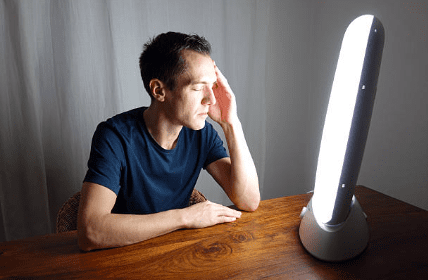In general, light therapy is the use of certain frequencies of bright light exposure to help improve a person’s mood and mood regulation, which can be very helpful for people suffering from depression. For instance, in a light therapy session you may sit near a light therapy box, which is designed to specifically emit bright light that mimics the natural properties of sunlight. By utilizing the proper frequencies and exposure times, this therapy can increase serotonin and norepinephrine levels, which are chemicals in your brain that impact an individual’s mood regulation.
Light therapy is usually used to help treat major depressive disorder (MDD) with seasonal patterns (sometimes known as seasonal affective disorder, or SAD). This type of depression occurs at a certain time of year, typically in the winter since there is less daylight. This therapeutic light can also help treat other conditions, such as sleep disorders and other kinds of depression.
What Is Light Therapy and How Does it Work?
Light therapy is thankfully simple to use. You’ll need to get a light therapy box or lamp, which you can then plug in, turn on, and find a seat that’s comfortable and close enough for your eyes and skin to take in the light for a specific amount of time. Typically, you should try to be within one and a half and two feet from the lightbox in order to get the most benefit. The light machines themselves are usually made with fluorescent lights on a metal reflective base with a plastic screen along the top to diffuse the light and filter out riskier ultraviolet light (UV) rays, just like the sun normally makes.
The light boxes can help increase melatonin, serotonin, and vitamin D levels for patients. But it’s crucial to follow the manufacturer’s instructions with respect to the actual distance needed to absorb the right amount of light. Research suggests that it’s beneficial to receive approximately 10,000 lux of exposure at the right distance, which usually takes place over 30 minutes of exposure. Avoid looking directly into the light box for the whole session since it could damage your eyes. Instead, the idea is that the exposure should help your eyes pick up the light indirectly.
How Light Therapy Helps With Depression
Researchers aren’t completely sure how or why light therapy is effective, but studies indicate that the treatment does provide relief of symptoms for many people. Experts think the light emitted by a lightbox may cause the production of serotonin through the same process that natural sunlight does. With the right amount of exposure to the right frequencies of light, you can increase the probability of serotonin production that helps alleviate symptoms of depression.
Light therapy can be an effective treatment for a variety of depression types, including SAD. This type of light exposure can help a person’s circadian rhythm stabilize or remain stable and is typically thought of as a strong first treatment option for SAD, according to a review published in 2017 in the Einstein Journal of Biology and Medicine.
If you or a loved one are struggling with symptoms of depression, incorporating light therapy sessions at home or with a licensed professional may be a great option. If you’ve already tried light therapy and even other treatment methods already, transcranial magnetic stimulation treatment could also be a great option.
TMS Center of the Lehigh Valley is one of the first TMS centers in the area and one of the most experienced along the entire east coast. So if you want more information about utilizing light therapy or transcranial magnetic stimulation, don’t hesitate to contact us today.

